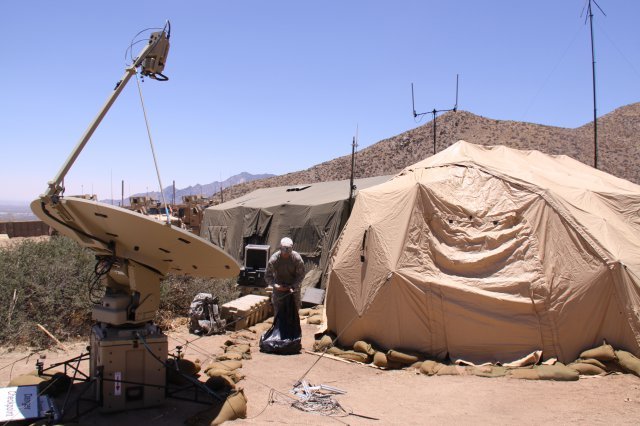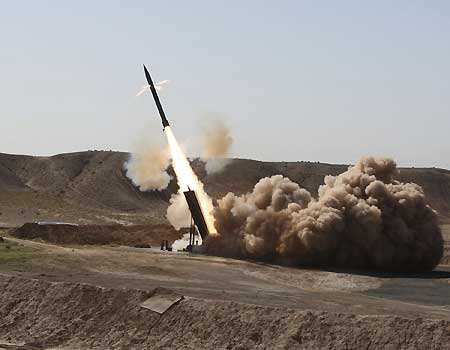The Army is immersed in an ambitious Network Integration Evaluation exercise here, designed to simultaneously test programs of record and assess a host of emerging network technologies, Army senior leaders said.
The Network Integration Evaluation, or NIE, is a key part of the Army’s network strategy, and includes five programs of record going though formal limited user tests, as well as a host of other technologies. The evaluation began to assess the scope and readiness of these emerging technologies the first week of June and runs through mid July.
At the heart of the exercise in an overarching effort to develop a single battlefield network able to push key information to the Soldier, linking them to command posts, vehicles on-the-move and higher headquarters. The idea is to use the best available technologies to move information, voice, video, data and images faster, further and more efficiently across the force.
“The network will literally redefine how we fight,” said Vice Chief of Staff of the Army Gen. Peter W. Chiarelli. “Ultimately, the network will connect leaders, Soldiers, Sailors, Airmen, Marines at all levels, at every echelon of command, in any formation, and across the entire team, with the right information quickly and seamlessly. I am confident it will make our various formations more lethal, faster, and more survivable in today’s battlefield.”
Central to the NIE is the continued evaluation of non-proprietary high bandwidth waveforms such as Soldier Radio Waveform, or SRW, and Wideband Networking Waveform. These use a larger portion of the available spectrum than legacy waveforms to move voice, video, images and data in real-time across multiple nodes in the force.
The waveforms, and indeed many of the technologies, are designed with standards aimed at meeting the needs of all the services in order to accommodate the potential for joint service involvement in the network.
“We’re working very close with partners up at Office of the Secretary of Defense in laying this out,” Chiarelli said. “I’ve invited them all [other Services] out to see what we’re doing. I see this evolving very, very quickly into a test-bed that can be used not just by the Army but by all services.”
Overall, the technologies being evaluated include a wide range of capabilities such as software programmable radio, satellites, sensors and smart phones.
The programs undergoing formal Limited User Tests, or LUTs, include:
- — The Joint Tactical Radio Systems, Handheld Manpack Small Form Fit, or HMS, is a multi-channel, Soldier-mounted software-programmable radio able to transmit voice, video, data and images using high band-width waveforms such as SRW.
- — The Joint Capabilities Release, or JCR, is the next-generation software for Force Battle Command Brigade and Below, or FBCB2, display screens, featuring Army/Marine Corps interoperability and advanced mapping tool kits.
- — The Mounted Soldier System, or MSS, is a combat-vehicle Soldier ensemble which integrates advanced gear such as a helmet-mounted display and body cooling devices.
- — The Network Integration Kit, which is a vehicle-mounted communications and computing hub.
- — The SPIDER remote munitions delivery system
The NIE is the first in a series of semi-annual evaluations designed to integrate and mature the Army’s tactical network. In addition to the five systems undergoing formal LUTs, the NIE is also experimenting with 29 emerging technologies — such as smart phones and PDA’s and complex vehicle-based company command posts — in order to zero in on the best of emerging technologies able to deliver networked capabilities to Soldiers on the move in combat.
“The reality is these NIEs are as much about learning as they are about testing,” Chiarelli said. “After all, the only way to fix problems is to accurately identify them. Likewise, the most effective means for developing new, relevant doctrine and tactics is to conduct integrated network-enabled training exercises.”
The rationale for the NIE is to evaluate all of these technologies in relation to one another, in a combat-like environment, complete with mountains and desert-like terrain such as at White Sands Missile Range.
“We can evaluate new capabilities across the potential spectrum of conflict. We can evaluate them in terrain that our units are really having to deal with today in line-of-sight and non-line-of-sight challenges,” said Maj. Gen. Keith Walker, commander, Brigade Modernization Command. “If there is a capability that has merit, we can evaluate it and get feedback, not just on the material, the technical material piece, but [also] the implications of this equipment on our doctrine, on how we organize, how we train and how we develop leaders.”
The NIE provides Army testers and program managers the advantage of assessing how new and emerging technologies work in relation to one another from a system-of-systems perspective. The NIE is aimed at refining the acquisition of new technologies and blending programs of record with commercial, off-the-shelf solutions as part of a process designed to keep pace with rapid technological change, Army leaders explained.
Recently, the Army issued notification that it is seeking interested industry sources with mature networked technology solutions to participate in one of two upcoming Network Integration Evaluation events to be held in the fall of 2011 and the spring of 2012.
In what is termed a sources sought notification, the Army, through Program Executive Office Integration, is seeking interested industry partners who would like to demonstrate mature network technologies to enhance tactical network capability.
The purpose of the sources-sought notice is to identify emerging capabilities to be evaluated against a set of entrance criteria and to provide an opportunity for selected mature capabilities to participate in Network Integration Evaluations. The Army is seeking solutions that address specific network capabilities, that are at the representative model or prototype system stage, and that have been tested in a relevant environment.
“To ensure that the Army only delivers the best integrated network capabilities to our Soldiers, we are only seeking mature capabilities for possible entrance into this evaluation cycle,” said Col. Dan Hughes, director of systems integration, Program Executive Office Integration. “This represents a major step up in the capabilities’ demonstrated readiness, including prototypes that have been tested in a high-fidelity laboratory environment or in a simulated operational environment.”
The NIE — and subsequent exercises planned to take place on approximately a six-month rotation — are geared toward speeding up and improving the way new networking technologies are delivered to Soldiers, in part by ensuring that the integration of new capability is properly solidified before items are sent into combat.
“The Army will buy what it needs, when it needs it, for those who need it. This allows us to buy less, more often, and incrementally improve network capability over time,” Chiarelli said. “Simply stated, I see these NIEs not as evolutionary events, but as representing a revolutionary new approach that will potentially change how we provide new capabilities in the future.”











